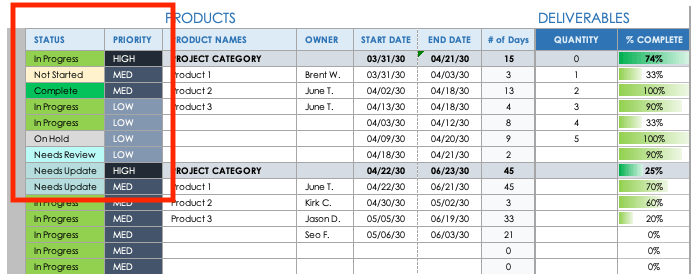Basic Production Scheduling Template
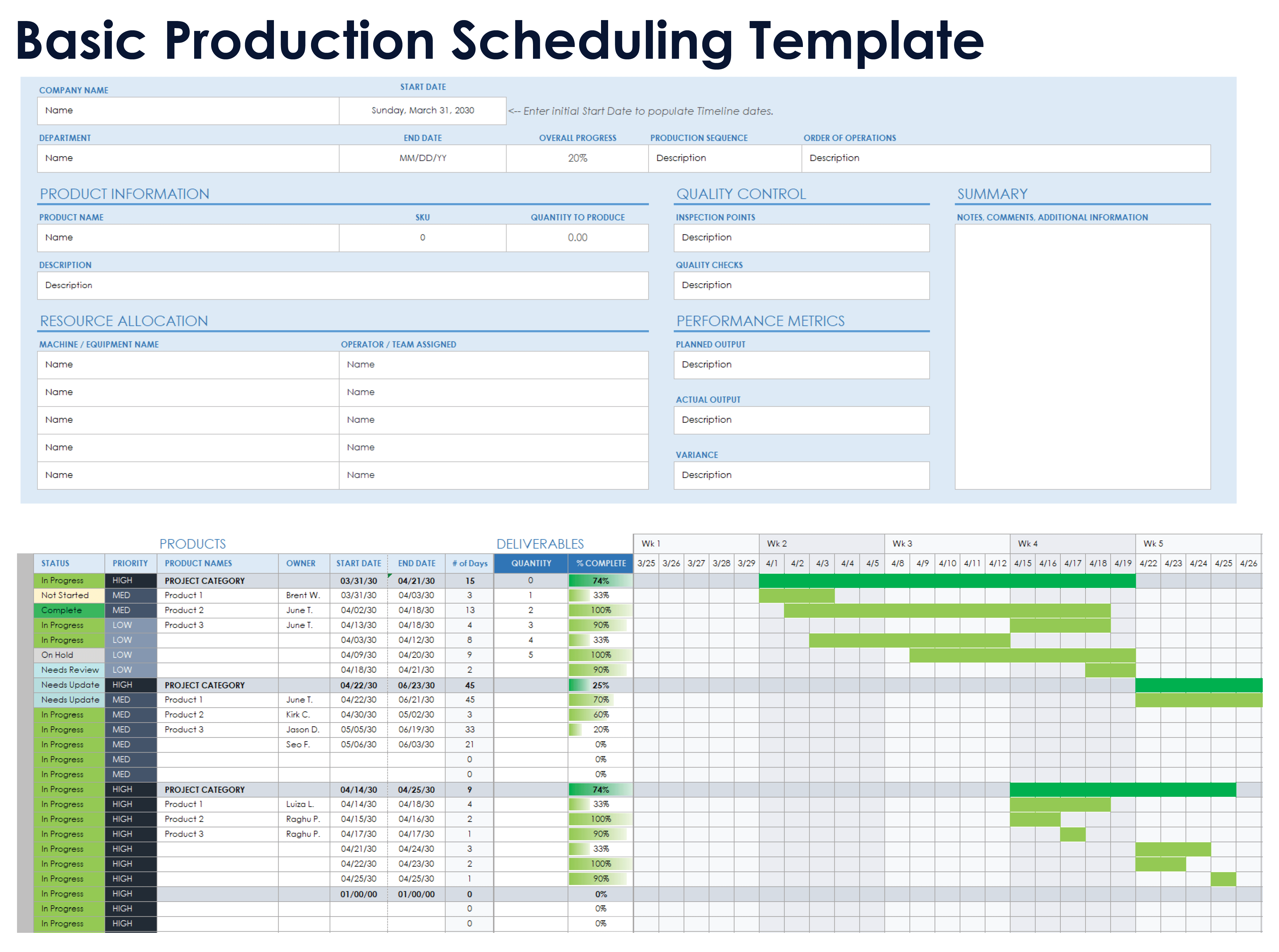
Download a Basic Production Scheduling Template for
When to Use This Template: Production managers can use this template to outline production activities, assign tasks to specific teams or individuals, and track the progress of each task. Use this template to manage resources, allocate work, and maintain clear communication across the production team to ensure that you remain organized and meet production goals and deadlines.
Notable Template Features: This template includes dedicated sections to schedule daily or weekly production tasks, track progress, manage resources, and monitor completion status. The template also provides areas to document key production details such as resource allocation, shift schedules, and inventory levels, as well as to identify potential bottlenecks.
For more information, visit our complete guide to production scheduling basics.
Master Production Scheduling Template
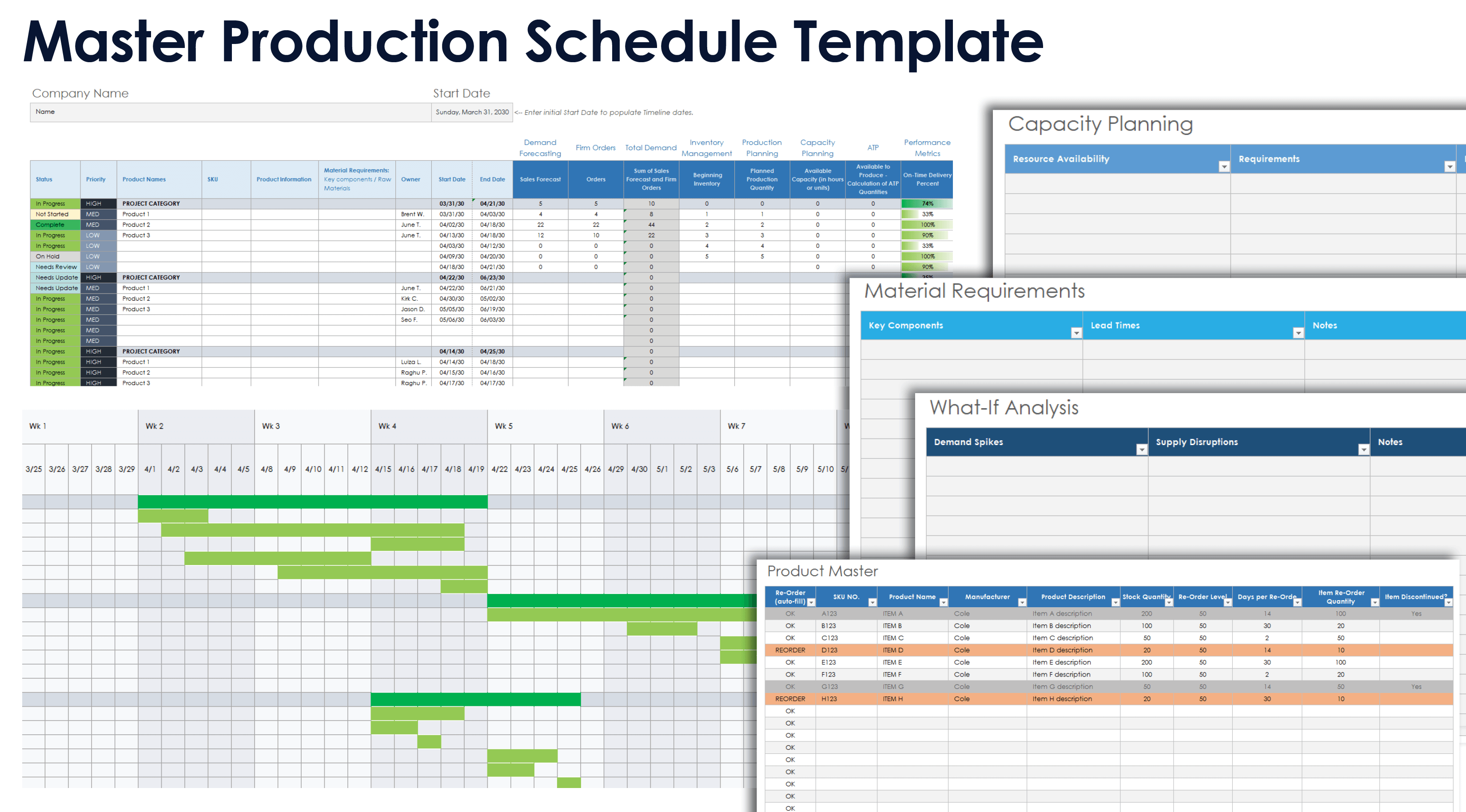
Download a Master Production Scheduling Template for
When to Use This Template: This template is particularly useful in environments where you need to tightly coordinate production needs with sales, supply chain, and inventory management to meet customer orders on time and within budget. Use this template to develop a detailed plan that integrates all aspects of production, from forecasting demand to final delivery, and to align production schedules with customer demand so you can properly allocate resources.
Notable Template Features: This template includes sections to forecast demand, set production targets, and align production output with market needs. The template also features sections to integrate sales forecasts, manage safety stock, and ensure that production aligns with both current and future demand.
Learn how to create your own Excel schedule with a variety of free templates to get started.
Daily Production Scheduling Template
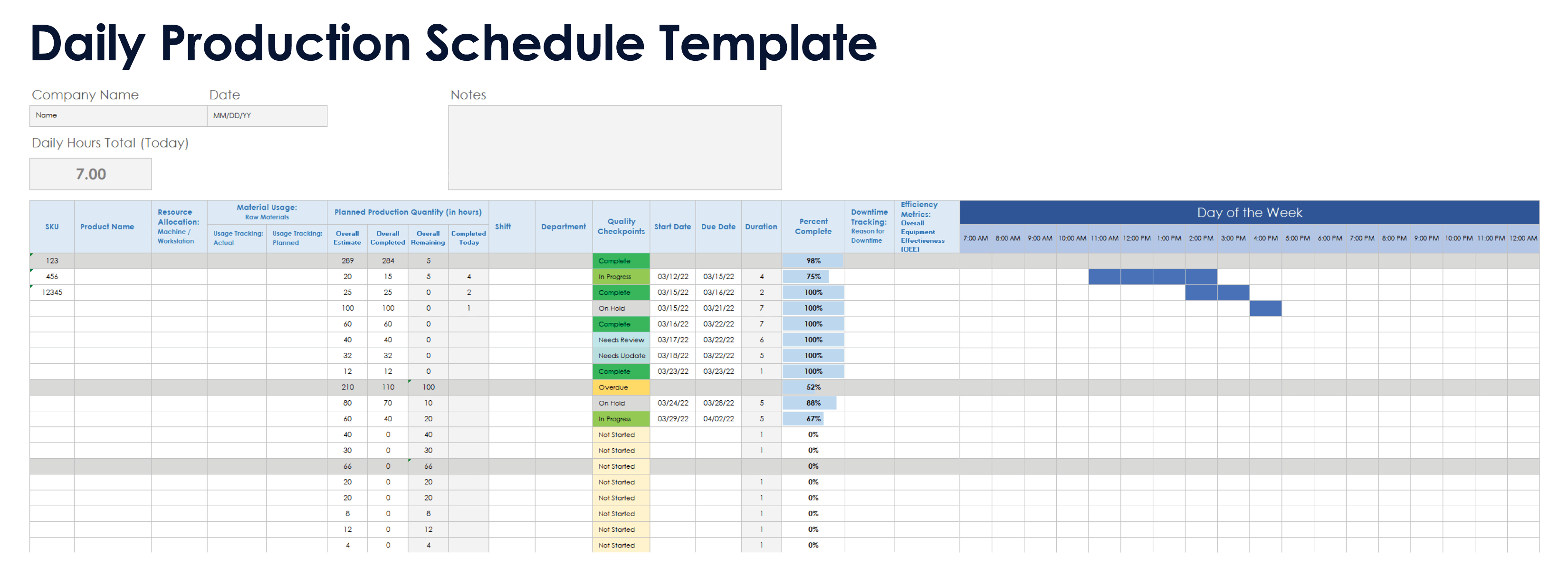
Download a Daily Production Scheduling Template for
When to Use This Template: This template is designed to provide a clear, concise plan for daily production tasks. It is especially useful for operations teams that require tight coordination and need to make real-time adjustments to meet daily production targets and respond to any immediate challenges on the production floor.
Notable Template Features: The daily production scheduling template includes sections to list all daily production tasks, assign them to specific teams or individuals, and track completion status. Additionally, it provides space for you to detail shift schedules, allocate resources, and monitor inventory levels as they change in real time. Finally, note any production issues that arise and document quick fixes or adjustments.
Visit this page of free project schedule templates for more options to keep your projects on track.
Weekly Production Scheduling Template
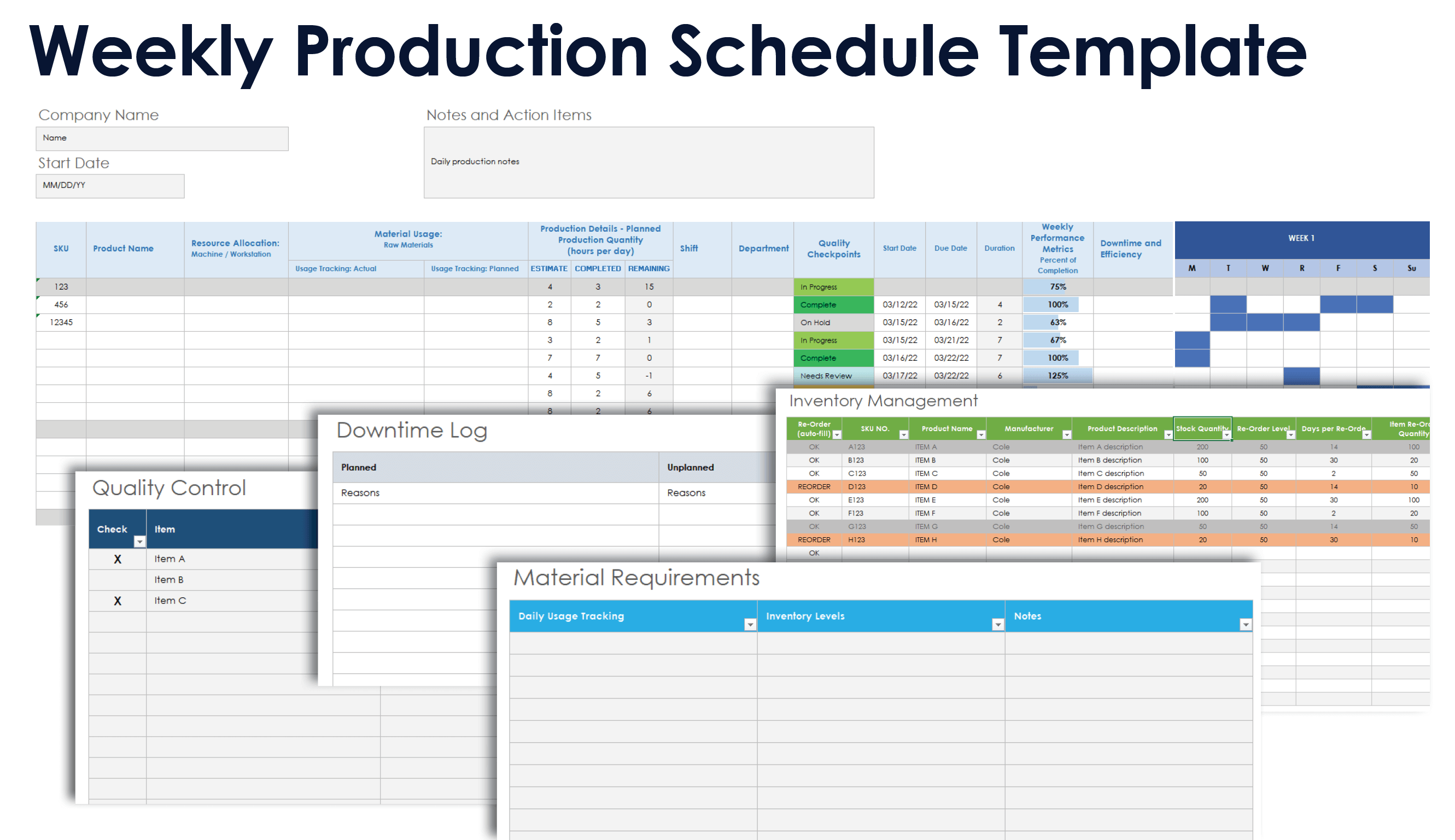
Download a Weekly Production Scheduling Template for
When to Use This Template: Organizations can use this template to view both detailed tracking activities and overall weekly performance at once. It includes features to support weekly planning, resource allocation, and provides a structured approach to setting and achieving daily production goals, while allowing you to easily compare performance across the days of the week.
Notable Template Features: This template includes dedicated sections for daily breakdowns and allows you to track daily production goals, planned production quantities, and overall inventory management. The template also includes areas for allocating resources, such as machine or workstation assignments, and tracks material requirements and daily quality control results. It also includes a separate section for downtime logging, where teams can document planned and unplanned maintenance, and a summary section, where you can present weekly totals and key performance metrics.
Mass Production Scheduling Template
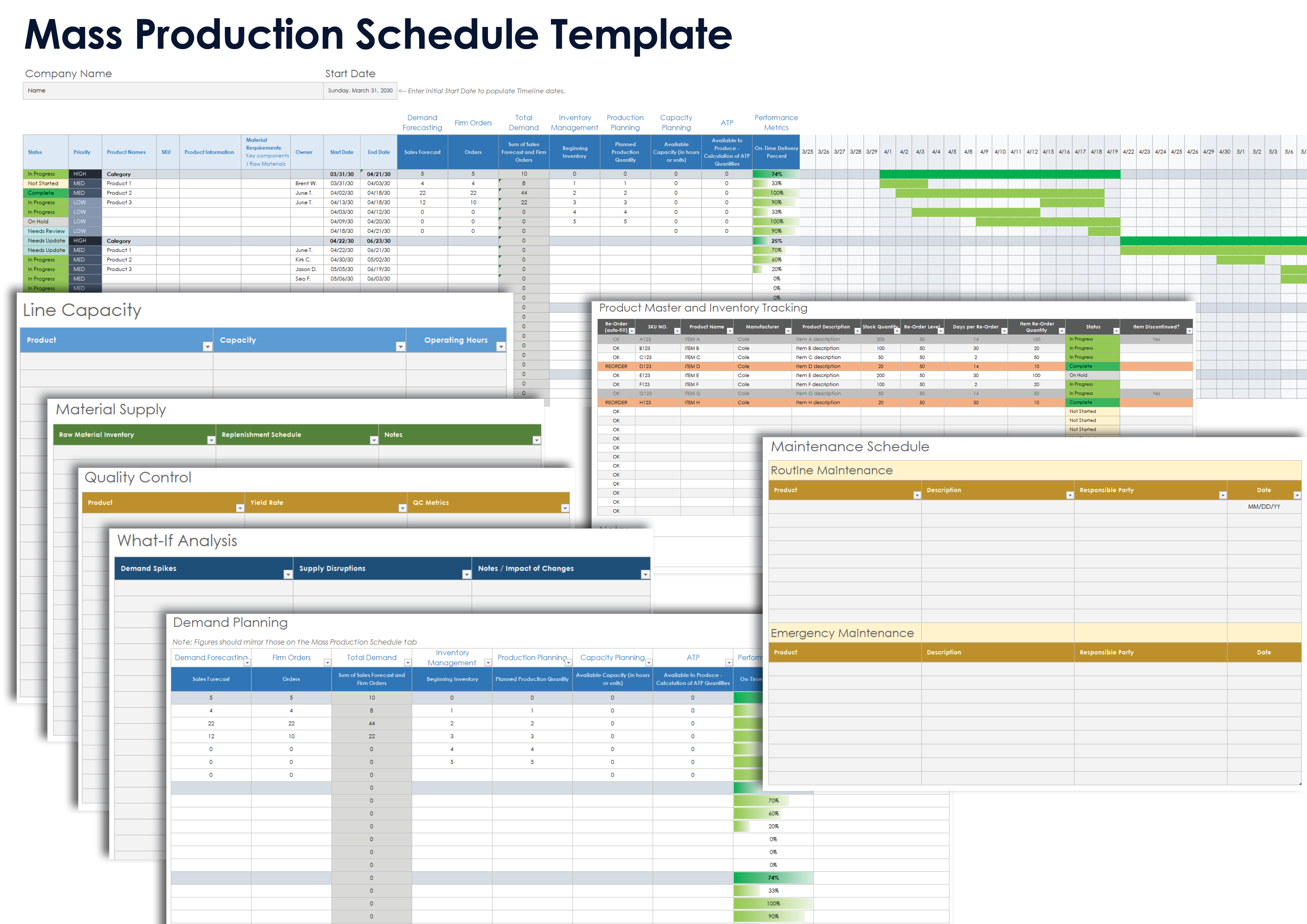
Download a Mass Production Scheduling Template for
When to Use This Template: Production planners and managers who work in high-volume, continuous production environments can use this template to optimize production schedules for maximum throughput, reduce changeover times, and provide a comprehensive view of production flow across multiple lines and shifts. This template is also useful for ensuring that you meet customer demand efficiently while maintaining high operational efficiency and minimizing downtime.
Notable Template Features: This template features a month-long scheduling grid that tracks production runs across multiple lines. It includes a dashboard for key metrics such as line utilization and production quantities, as well as sheets for product details, line capacity, inventory tracking, and more. The template also features color-coded cells, automated calculations, and simple charts to make it easy to monitor and adjust schedules for efficient production.
Lean Production Scheduling Template
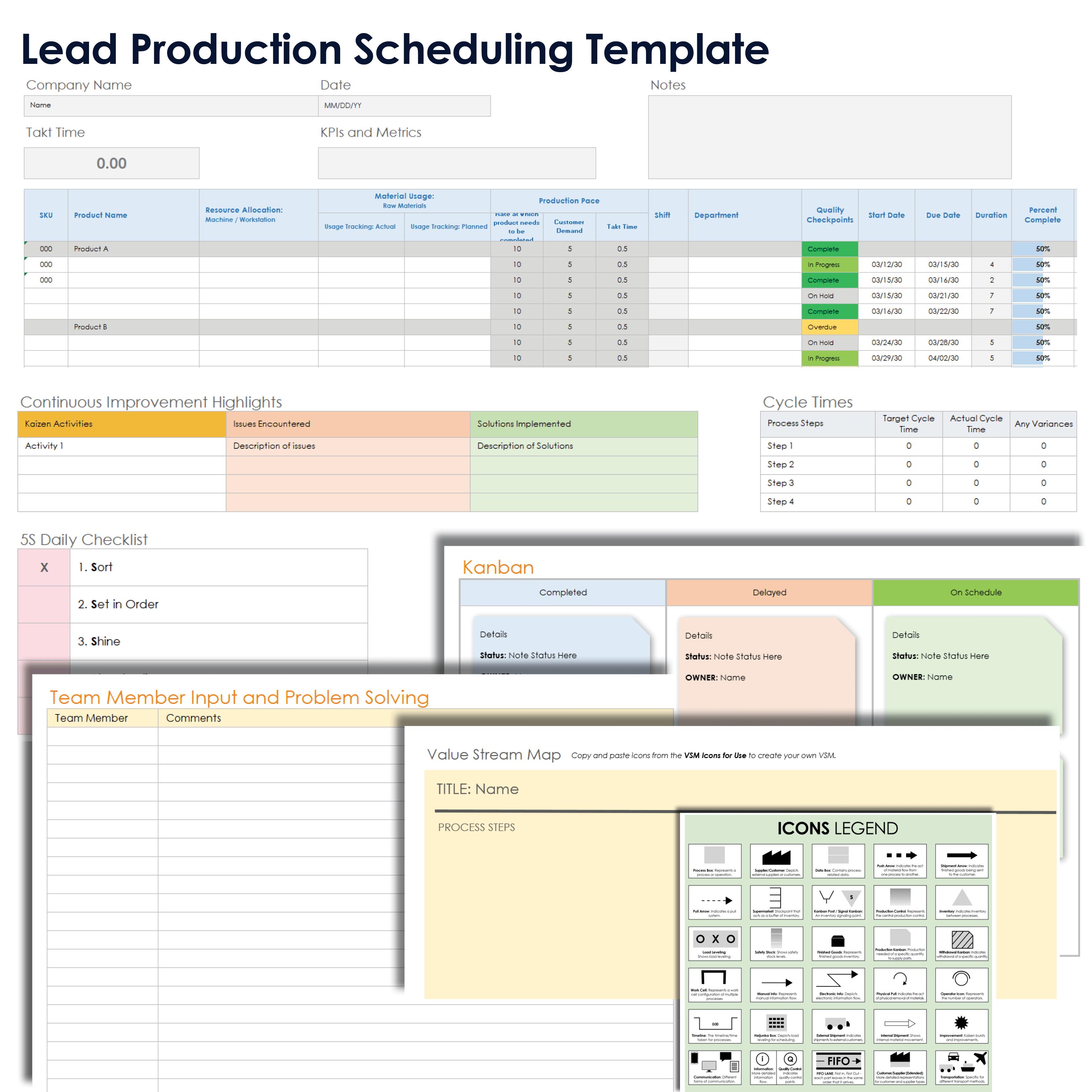
Download a Lean Production Scheduling Template for
When to Use This Template: This Lean production scheduling template is ideal for production planners and managers who work in Lean manufacturing environments. Use it to help eliminate waste, improve efficiency, and provide a clear overview of production activities. You can also use it to align production schedules with demand, enhance resource allocation, and maintain a continuous flow in production.
Notable Template Features: This template features a streamlined grid that aligns production activities with takt time (the rate you need to produce product to meet customer demand) and production pace. It includes sections for real-time KPI tracking, visual cues for continuous improvement, and easy-to-update Kanban cards. This template also features color-coded elements and automatically calculates totals, which makes it even easier to follow Lean production practices.
Finite Capacity Production Scheduling Template
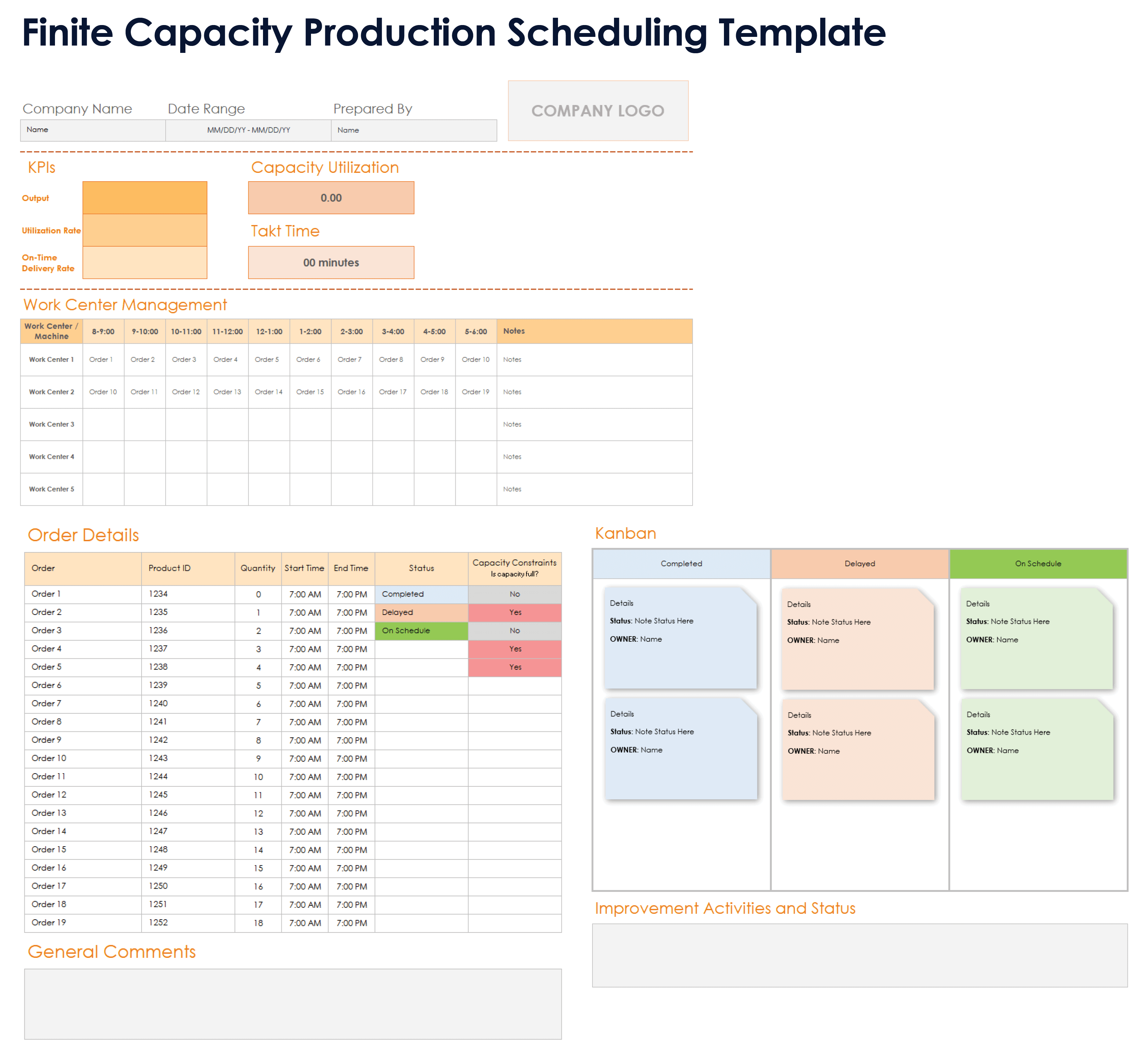
Download a Finite Capacity Production Scheduling Template for
When to Use This Template: Production planners and managers can use this template to schedule tasks based on the actual capacity of resources such as machines, labor, and materials. This will help ensure that you allocate resources efficiently and set realistic production schedules. This template is also useful for balancing workloads and maintaining a smooth production flow.
Notable Template Features: The template includes a detailed capacity grid that matches production tasks with available resources. It features sections for you to track capacity in real time, allocate resources, and identify bottlenecks. The template also includes automated calculations, color-coded indicators, and space for adjustments so you can easily manage capacity limits and ensure that you meet production targets without exceeding available resources.
Batch Production Scheduling Template
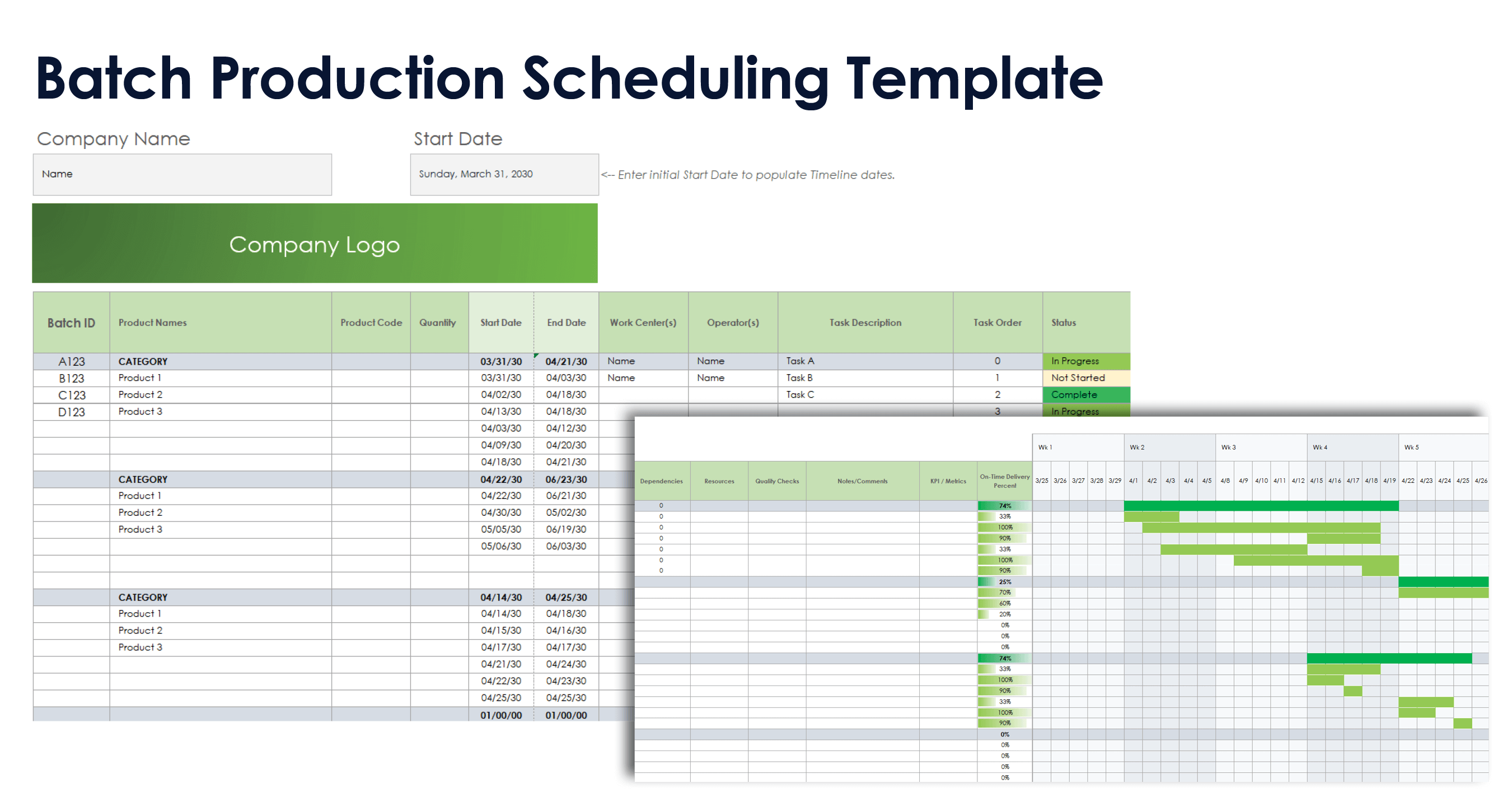
Download a Batch Production Scheduling Template for
When to Use This Template: This template is perfect for production managers who oversee manufacturing processes where products are made in groups or batches. Use this template to streamline batch production scheduling and ensure that each batch is completed smoothly and on time. You can also use this template to manage production runs and maintain visibility over the progress of each batch.
Notable Template Features: This template includes sections for you to define batch sizes, track production timelines, and manage the sequence of batches. It features a daily or weekly breakdown of batch schedules, space for resource allocation, and areas to monitor inventory levels and quality checks. The template also includes automated calculations for batch completion times and color-coded indicators to highlight the status of each batch, which makes it easy to keep production on track.
Job Shop Scheduling Template
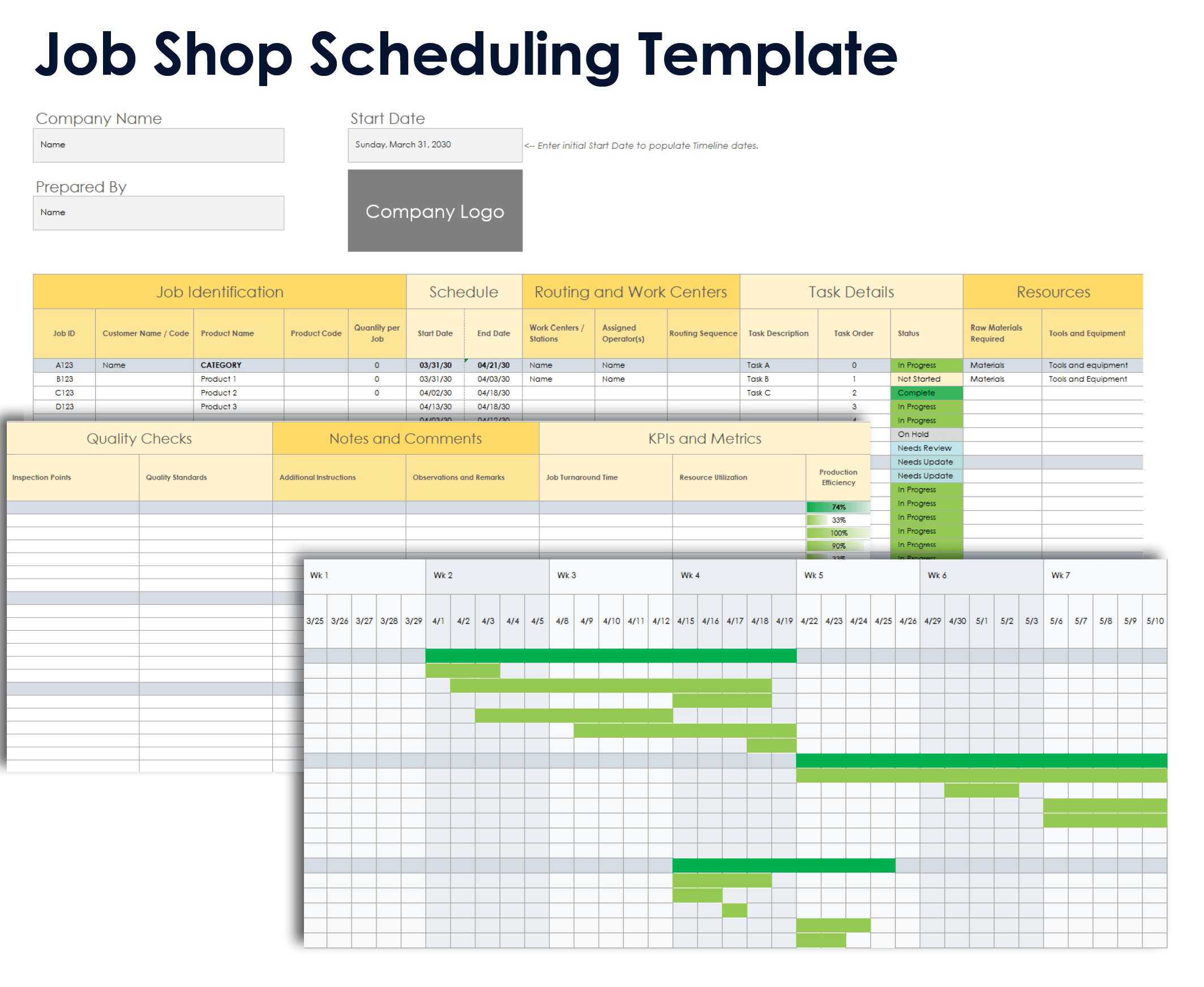
Download a Job Shop Scheduling Template for
When to Use This Template: This template is intended for production managers and planners who work in environments where customized, small-batch jobs are the norm. Select this template when you need to manage the complexity of scheduling jobs that use multiple workstations — doing so will help ensure that you use resources efficiently and complete jobs in a timely manner. Use this template to organize and track multiple jobs with different requirements and timelines.
Notable Template Features: The job shop scheduling template features a flexible scheduling grid that enables adaptable workflows across different workstations. It includes sections for job-specific details, resource allocation, and time tracking for each workstation, and it allows you to easily adjust job sequences and timelines, with automated calculations for job completion times. It also includes visual markers, such as color-coded status indicators and charts, to help you monitor job progress and identify bottlenecks.
Just-in-Time (JIT) Production Scheduling Template
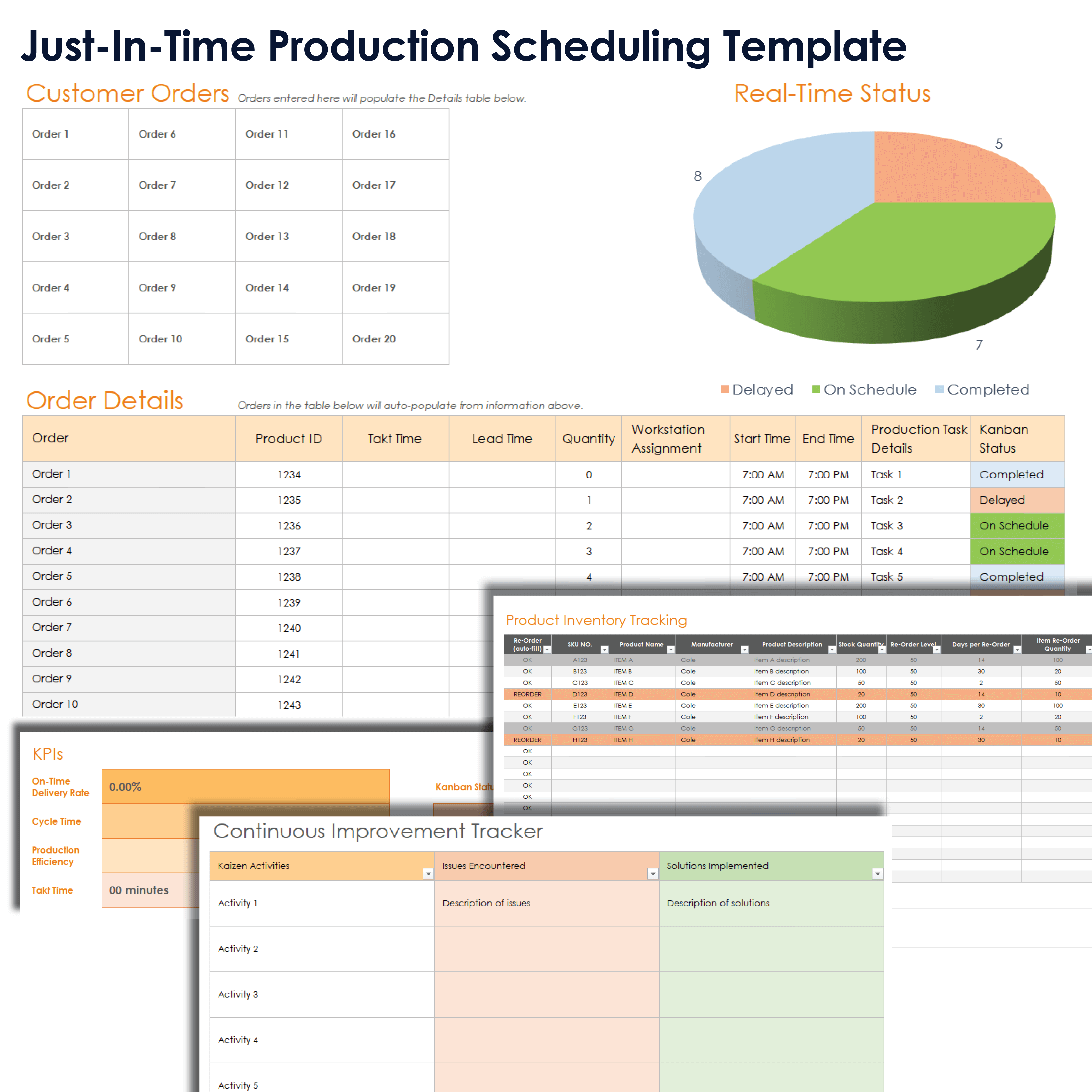
Download a Just-in-Time Production Scheduling Template for
When to Use This Template: Production managers can use this template to align production with customer demand while minimizing inventory levels. Select this template when efficiency and waste reduction are critical, ensuring that materials and products are available when they are needed, without excess. Use this template to streamline production processes, reduce lead times, and maintain a lean inventory system.
Notable Template Features: The just-in-time (JIT) production scheduling template includes a dynamic scheduling grid that links production activities directly to customer orders. It features sections for you to track material requirements, production status, and delivery timelines in real time, and it features automated alerts for replenishment needs. This template also integrates performance metrics to monitor production efficiency and provides color-coded timelines and charts to help ensure that production stays on track.
Agile Production Scheduling Template
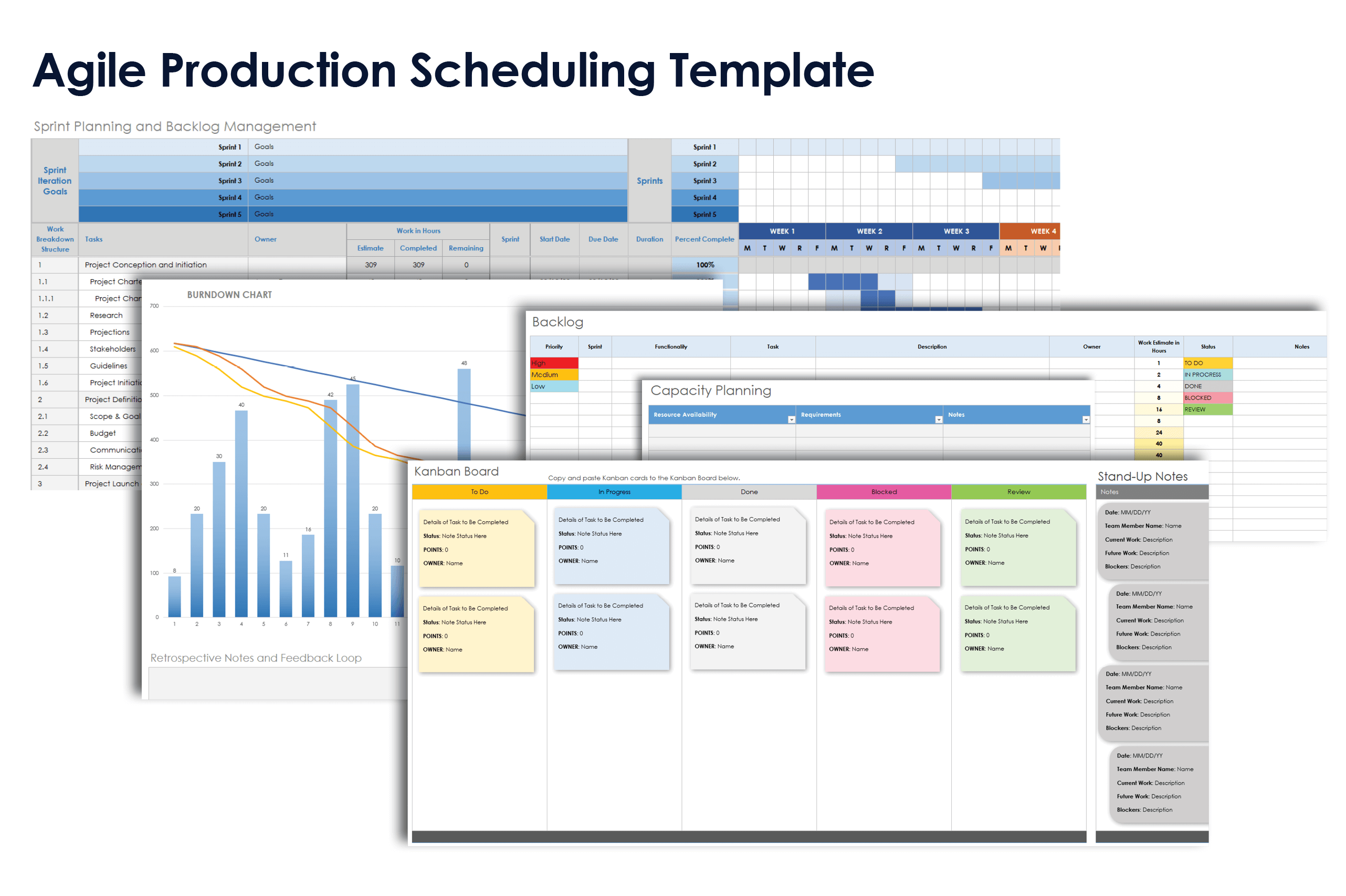
Download an Agile Production Scheduling Template for
When to Use This Template: The template is ideal for production teams that operate in environments that require a lot of flexibility and agility in response to changes in demand or production conditions. This template is designed to support iterative production processes, frequent adjustments, and collaboration among team members. Use this template to manage production in industries where adaptability and speed are critical to maintaining efficiency and meeting customer needs.
Notable Template Features: This template includes a flexible scheduling grid that allows you to make quick adjustments to production plans. It features sections for sprint planning, task prioritization, and team assignments, and it integrates real-time progress tracking, feedback loops, and performance metrics to support continuous improvement. Visual tools such as Kanban boards, burndown charts, and color-coded task lists help teams stay organized and responsive in a fast-paced production environment.
Types of Production Scheduling and Planning Templates
There are several common categories of production scheduling, including demand-driven scheduling, capacity and resource management, flexible production, and production flow and efficiency. Each type will help you ensure smooth production and minimize waste, and each works best within certain industries or work environments.
Learn about the four most common types of production scheduling templates below:
Demand-Driven Scheduling: This style focuses on aligning production with actual customer demand, minimizing waste, and reducing inventory levels. This approach ensures that you tie production activities to what customers are currently purchasing, with the goal of avoiding overproduction. The JIT (just-in-time) production scheduling template, for example, is designed for an operation that produces goods only as they are needed, ensuring an efficient operation that responds quickly to changes in demand.
Capacity and Resource Management: Capacity and resource management templates help you schedule production within the actual limits of available resources, such as machinery, labor, and materials. This ensures that production plans are realistic and achievable, and helps you avoid bottlenecks and inefficiencies. The finite capacity production scheduling template is a key example, as it helps in planning production schedules that fully utilize available resources without exceeding their capacity.
Custom and Flexible Production: This category works best in environments where production must adapt quickly to specific customer orders or rapidly changing market conditions. This approach allows for tailored workflows and quick adjustments to production plans. The job shop production scheduling template is an example of this, as it helps organize production around custom jobs, ensuring that each order is completed on time and according to specifications.
Production Flow and Efficiency: This category of templates aims to streamline production processes to maximize output while minimizing waste and downtime. This category emphasizes the importance of organized, efficient workflows that optimize production schedules for better overall performance. The batch production scheduling template exemplifies this approach by managing production in well-organized batches, optimizing the use of resources and minimizing setup times to keep the production line moving smoothly.
Elements in Production Planning and Scheduling Templates
Regardless of the specific template you choose, most production planning and scheduling templates include common elements, such as product information, resource allocation, material requirements, inventory levels, and more.
Learn more about the key elements of any production planning template:
- Capacity Planning: Use these sections to analyze and plan resource capacity, including available hours and workload distribution.
- Change Log: Document and track changes made to the production plan.
- Cost Tracking: Monitor all production costs, including labor, materials, and overhead.
- Demand Forecasting: Input and analyze sales forecasts to inform production planning.
- Dependencies and Constraints: Note any task dependencies or resource constraints that affect scheduling.
- Inventory Levels: Track current inventory levels of raw materials, works-in-progress (WIP), and finished goods.
- Material Requirements: List the required raw materials, components, and necessary production quantities.
- Notes and Comments: List additional information, explanations, or instructions related to specific production tasks or processes.
- Performance Metrics: Track key performance indicators (KPIs), such as efficiency, throughput, and on-time delivery rates.
- Product Information: The template will include fields for product names, descriptions, SKUs, and any relevant product-specific details.
- Production Quantities: Specify the number of units you will produce for each product or product family.
- Production Sequence: Outline the order of production tasks or batches.
- Resource Allocation: Assign and track the use of machines, equipment, labor, and other production resources.
- Quality Control Checkpoints: Schedule and track quality inspections throughout the production process.
- Status Updates: Indicate the current status of production tasks or orders (e.g., planned, in-progress, completed).
- Supplier Information: Note any relevant supplier details, lead times, and order quantities for required materials.
- Time Frames: Note start and end dates, production periods, or specific time slots for tasks.
How to Create a Production Schedule
Creating an effective production schedule is crucial for maximizing efficiency and meeting production goals. Follow these streamlined steps to get started with your production schedule using our template:
- Download the basic production scheduling template .
- Open the downloaded file.
- Fill in the header section of the template. This includes the company name, department name, and date range.
- Fill in the Product Information section of the template. This includes the product name and SKU, the quantity to be produced, and a description of the product.
- Enter the resources you intend to allocate to this product. This includes any machines or equipment and the operator or team assigned to each, as well as start and end dates and times for each production task.
- Track status and performance metrics. Use the drop-down menu to indicate the status of each task (e.g., Not Started, In Progress, Completed), and compare planned output with actual output and review any variances using the provided formulas
- Finalize and review the schedule. Once everything is complete, save the template and share it with the production team.
By following these steps, you’ll create an organized, efficient production schedule that helps you stay on track and meet your production goals.
You can also create a schedule from scratch — learn how to do so in Excel with our complete guide.
Streamline Production Planning and Scheduling with Real-Time Work Management in Smartsheet
Empower your people to go above and beyond with a flexible platform designed to match the needs of your team — and adapt as those needs change. The Smartsheet platform makes it easy to plan, capture, manage, and report on work from anywhere, helping your team be more effective and get more done. Report on key metrics and get real-time visibility into work as it happens with roll-up reports, dashboards, and automated workflows built to keep your team connected and informed. When teams have clarity into the work getting done, there’s no telling how much more they can accomplish in the same amount of time. Try Smartsheet for free, today.



